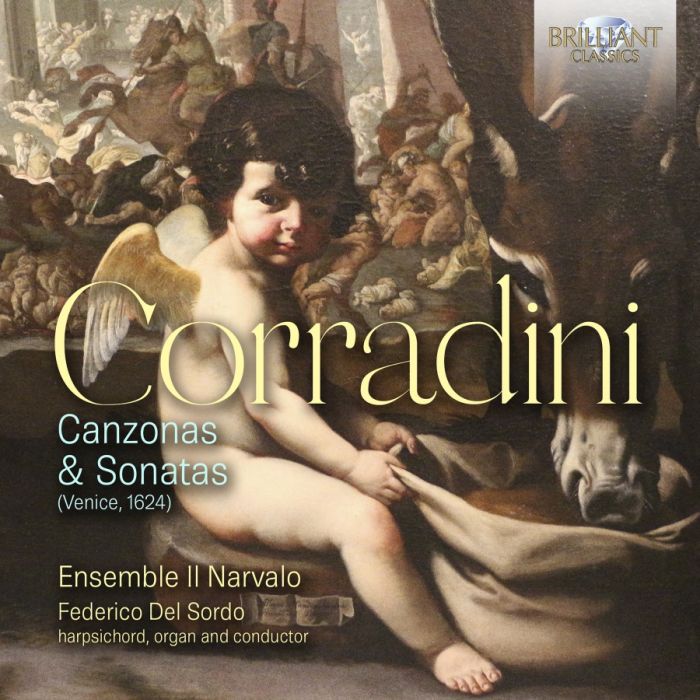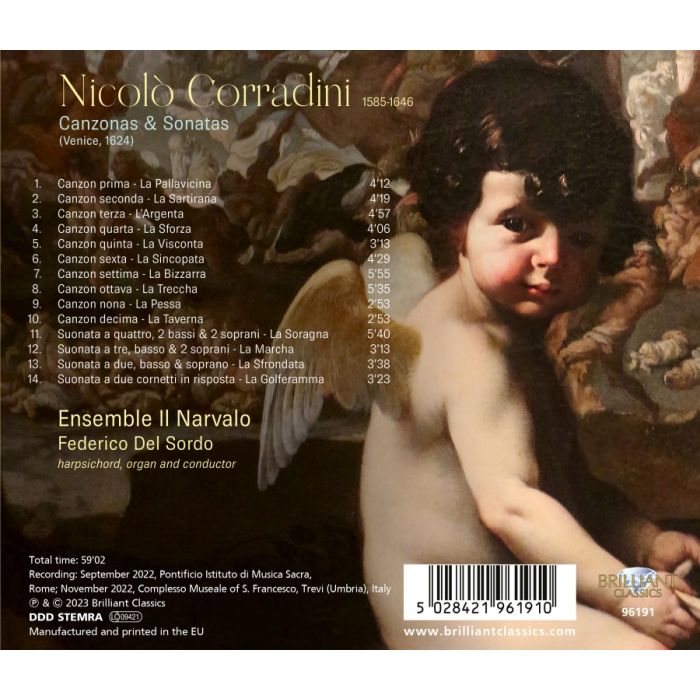
(Produkt nie został jeszcze oceniony)
kompozytor
Corradini, Nicolò
tytuł
Corradini: Canzonas & Sonatas
wykonawcy
Del Sordo, Federico, Ensemble Il Narvalo
nr katalogowy
96191
opis
Nicolò Corradini was born in the late 16th century, and died in 1646. He spent most of his life in Cremona, the city where he was most likely born. Corradini received his early musical education from fellow Cremonese citizen Giovanni Battista Morsellino. In 1611 he was appointed organist of the Church of San Pietro in Cremona, and that same year he was also asked to accompany the Litanies of the Virgin, which were traditionally performed at Cremona Cathedral every Saturday and on all feast days dedicated to the Virgin Mary. In 1635 he took up the role of organist at the cathedral. Corradini’s works include a book of Madrigali a 5 et a 8 voci con Sinfonie di Viole (published in Venice in 1620).
•Corradini: Canzon nona - La pessa
•Corradini: Canzon ottava - La treccha
•Corradini: Canzon prima - La pallavicina
•Corradini: Canzon quarta - La sforza
•Corradini: Canzon quinta - La visconta
•Canzon seconda - La sartirana
•Corradini: Canzon settima - La bizzarra
•Corradini: Canzon sexta - La sincopata
•Corradini: Canzon terza - L’argenta
•Corradini: Suonata a due cornetti in risposta - La golferamma
•Corradini: Suonata a due, basso & soprano - La sfrondata
•Corradini: Suonata a quattro, 2 bassi & 2 soprani - La soragna
•Corradini: Suonata a tre, basso & 2 soprani - La marcha
This new recording presents the Canzonas. In keeping with a custom that was widespread in the first half of the 16th century, most of the titles of these compositions refer to the surnames of families or illustrious personalities linked to Cremonese patronage. These rich instrumental works are played here using a lavish instrumental ensemble, including 2 violins, viola, recorder, cornet, gamba, theorbo, violone, organ, harpsichord and dulciana.
Another enterprising recording by Federico Del Sordo, keyboard player and musicologist, never tired of discovering hidden gems from the Renaissance and Baroque of his native country Italy.
Works:
•Corradini: Canzon decima - La taverna
•Corradini: Canzon nona - La pessa
•Corradini: Canzon ottava - La treccha
•Corradini: Canzon prima - La pallavicina
•Corradini: Canzon quarta - La sforza
•Corradini: Canzon quinta - La visconta
•Canzon seconda - La sartirana
•Corradini: Canzon settima - La bizzarra
•Corradini: Canzon sexta - La sincopata
•Corradini: Canzon terza - L’argenta
•Corradini: Suonata a due cornetti in risposta - La golferamma
•Corradini: Suonata a due, basso & soprano - La sfrondata
•Corradini: Suonata a quattro, 2 bassi & 2 soprani - La soragna
•Corradini: Suonata a tre, basso & 2 soprani - La marcha
nośnik
CD x 1
wydawca
Brilliant Classics
data wydania
29.11.2023
EAN / kod kreskowy
5028421961910
55,00 zł
Produkt dostepny w niewielkiej ilości.
Wysyłka w ciągu 3 dni roboczych
Darmowa wysyłka dla zamówień powyżej 300 zł!
Darmowy kurier dla zamówień powyżej 500 zł!
sprawdź koszty wysyłki
